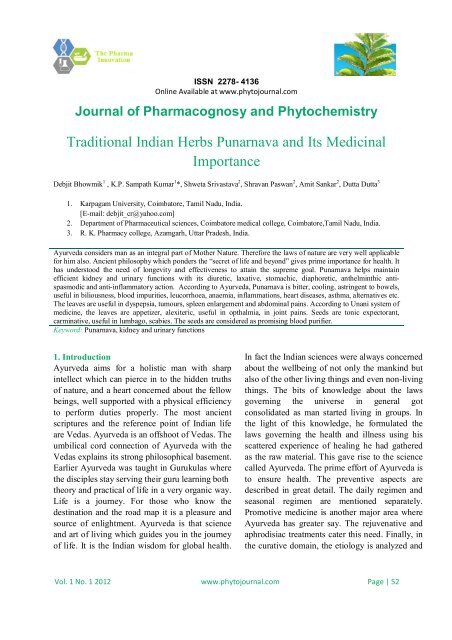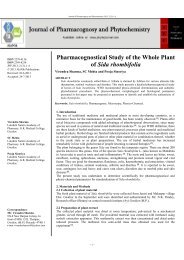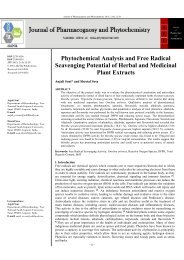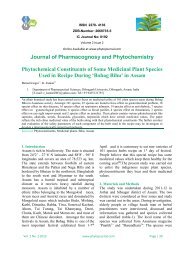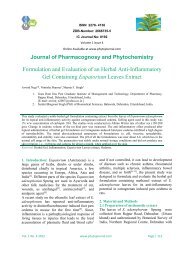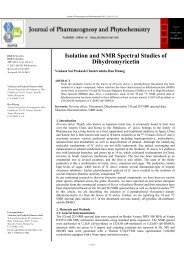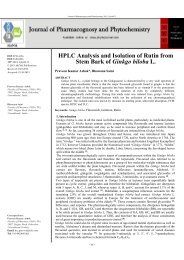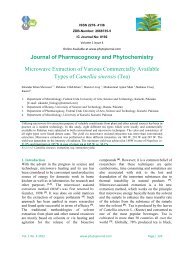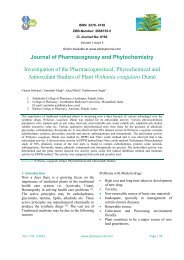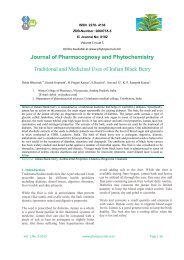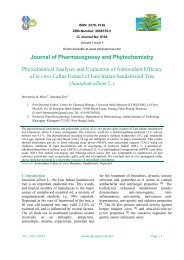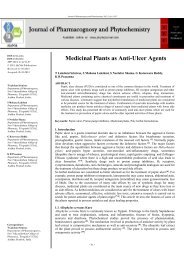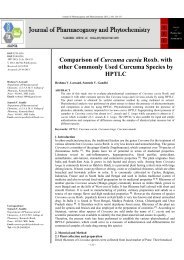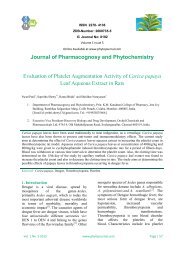Traditional Indian Herbs Punarnava and Its Medicinal Importance
Traditional Indian Herbs Punarnava and Its Medicinal Importance
Traditional Indian Herbs Punarnava and Its Medicinal Importance
You also want an ePaper? Increase the reach of your titles
YUMPU automatically turns print PDFs into web optimized ePapers that Google loves.
ISSN 2278- 4136Online Available at www.phytojournal.comJournal of Pharmacognosy <strong>and</strong> Phytochemistry<strong>Traditional</strong> <strong>Indian</strong> <strong>Herbs</strong> <strong>Punarnava</strong> <strong>and</strong> <strong>Its</strong> <strong>Medicinal</strong><strong>Importance</strong>Debjit Bhowmik 1 , K.P. Sampath Kumar 1 *, Shweta Srivastava 2 , Shravan Paswan 2 , Amit Sankar 2 , Dutta Dutta 31. Karpagam University, Coimbatore, Tamil Nadu, India.[E-mail: debjit_cr@yahoo.com]2. Department of Pharmaceutical sciences, Coimbatore medical college, Coimbatore,Tamil Nadu, India.3. R. K. Pharmacy college, Azamgarh, Uttar Pradesh, India.Ayurveda considers man as an integral part of Mother Nature. Therefore the laws of nature are very well applicablefor him also. Ancient philosophy which ponders the “secret of life <strong>and</strong> beyond” gives prime importance for health. Ithas understood the need of longevity <strong>and</strong> effectiveness to attain the supreme goal. <strong>Punarnava</strong> helps maintainefficient kidney <strong>and</strong> urinary functions with its diuretic, laxative, stomachic, diaphoretic, anthelminthic antispasmodic<strong>and</strong> anti-inflammatory action. According to Ayurveda, <strong>Punarnava</strong> is bitter, cooling, astringent to bowels,useful in biliousness, blood impurities, leucorrhoea, anaemia, inflammations, heart diseases, asthma, alternatives etc.The leaves are useful in dyspepsia, tumours, spleen enlargement <strong>and</strong> abdominal pains. According to Unani system ofmedicine, the leaves are appetizer, alexiteric, useful in opthalmia, in joint pains. Seeds are tonic expectorant,carminative, useful in lumbago, scabies. The seeds are considered as promising blood purifier.Keyword: <strong>Punarnava</strong>, kidney <strong>and</strong> urinary functions1. IntroductionAyurveda aims for a holistic man with sharpintellect which can pierce in to the hidden truthsof nature, <strong>and</strong> a heart concerned about the fellowbeings, well supported with a physical efficiencyto perform duties properly. The most ancientscriptures <strong>and</strong> the reference point of <strong>Indian</strong> lifeare Vedas. Ayurveda is an offshoot of Vedas. Theumbilical cord connection of Ayurveda with theVedas explains its strong philosophical basement.Earlier Ayurveda was taught in Gurukulas wherethe disciples stay serving their guru learning boththeory <strong>and</strong> practical of life in a very organic way.Life is a journey. For those who know thedestination <strong>and</strong> the road map it is a pleasure <strong>and</strong>source of enlightment. Ayurveda is that science<strong>and</strong> art of living which guides you in the journeyof life. It is the <strong>Indian</strong> wisdom for global health.In fact the <strong>Indian</strong> sciences were always concernedabout the wellbeing of not only the mankind butalso of the other living things <strong>and</strong> even non-livingthings. The bits of knowledge about the lawsgoverning the universe in general gotconsolidated as man started living in groups. Inthe light of this knowledge, he formulated thelaws governing the health <strong>and</strong> illness using hisscattered experience of healing he had gatheredas the raw material. This gave rise to the sciencecalled Ayurveda. The prime effort of Ayurveda isto ensure health. The preventive aspects aredescribed in great detail. The daily regimen <strong>and</strong>seasonal regimen are mentioned separately.Promotive medicine is another major area whereAyurveda has greater say. The rejuvenative <strong>and</strong>aphrodisiac treatments cater this need. Finally, inthe curative domain, the etiology is analyzed <strong>and</strong>Vol. 1 No. 1 2012 www.phytojournal.com Page | 52
Debjit Bhowmik , K.P. Sampath Kumar *,Shweta Srivastava, Shravan Paswan, Amit Sankar Duttathe imbalance it has created is evaluated beforedeciding the mode of treatment. The cardinalreasons for all diseases are the derailed intellect,weak will, <strong>and</strong> impaired memory together istermed as Pranjaparadha. To conceive the rightpractice of health one need clear intellect. To putthem in to practice one need a strong will. Toavoid the wrong doings of the past, memory hasto be intact. So Pranjaparadha remains the reasonbehind all the reasons that cause diseases. Apartfrom this, environmental <strong>and</strong> genetical reasons ofdisease are also recognized by Ayurveda. In alldiseases in spite of varying reasons, the basicreason is the imbalance of Tridosha <strong>and</strong> thetreatment principle is to bring back the normalcy.The disease can manifest as somatic, psychiatric,or psycho somatic. The balance is achieved byinternal purification, external treatmentmodalities, administering medicine internally <strong>and</strong>also using holistic methods addressing both body<strong>and</strong> mind. It ranges from pancha karma,Rasayana, Yoga, meditation <strong>and</strong> soon.Panchakarma is a unique treatment packagewhich is meant to cleanse both body <strong>and</strong> mind.They are emesis, purgation, enema, nasalmedication, <strong>and</strong> bloodletting. Rasayana is therejuvenative therapy which delays aging,provides immunity, enhances memory <strong>and</strong>increases sensory perception. Personal health isthe sum total of good food, good regimen, goodemotions <strong>and</strong> good environment. Ayurvedaelaborate the science of diet stating the pros <strong>and</strong>cons of different food items. The quantity <strong>and</strong>quality of food is instructed. Ayurveda warnsagainst the improper combination of food stuffsin detail <strong>and</strong> enlist the diseases it can cause.Aboutexercise, sleep, <strong>and</strong> sex, Ayurveda gives clearguidelines. The timings <strong>and</strong> frequency have to beadjusted according to the seasonal variations. Sixseasons have been identified in the <strong>Indian</strong> context<strong>and</strong> detailed seasonal regimens are given alongwith the method of changing one regimen toanother in a gradual smooth manner. This helpsto prevent seasonal disease <strong>and</strong> position the bodyagainst the seasonal variations. <strong>Punarnava</strong> isprimarily used for kidney <strong>and</strong> urinary disorders.An extract from the root extract is used as akidney <strong>and</strong> liver tonic. It improves thefunctioning of kidneys damaged by diabetes.Being a diuretic <strong>and</strong> mild laxative, it helps indetoxification <strong>and</strong> prevents fluid retention. It alsohelps in treating obesity. It is hepatoprotective,used in treatment of jaundice <strong>and</strong> other liverproblems. It provides relief from joint pains <strong>and</strong>inflammation, works as a blood purifier, givesimmunity to the body, <strong>and</strong> improves functioningof lungs. Some researchers have suggested that ithas antibacterial properties <strong>and</strong> used in treatmentof gonorrhea.1.1 Biological Sources<strong>Punarnava</strong> (Hogweed) literally means ‘bringback to life’ or ‘renewer’. It is a creeper thatgrows wild in India <strong>and</strong> Brazil throughout yearbut dries during the summer. It bears small fleshyleaves, small reddish pink flowers <strong>and</strong> fruits inwinter. It is bitter in taste <strong>and</strong> has cooling effect.It has very high medicinal value.Fig 1: punarnavaSimilar to its name it rejuvenates the whole bodyi.e. with routine use of <strong>Punarnava</strong> a fellowbecome young again – full of vigor <strong>and</strong>vitality. <strong>Punarnava</strong> corrects the digestivesystem, alleviates fluid retention <strong>and</strong> very usefulin managing heart diseases. <strong>Punarnava</strong> alsobenefits in anemia, hernia <strong>and</strong> respiratorydistress. <strong>Punarnava</strong> can also be taken in liverVol. 1 No. 1 2012 www.phytojournal.com Page | 53
Debjit Bhowmik , K.P. Sampath Kumar *,Shweta Srivastava, Shravan Paswan, Amit Sankar Duttaproblems <strong>and</strong> managing lipids <strong>and</strong> cholesterol inhealthy limits.1.2 Biological name: Boerhavia diffusaKingdom: PlantaeDivision: MagnoliophytaClass: MagnoliopsidaOrder: CaryophyllalesFamily: NyctaginaceaeGenus: Boerhavia1.3 Common Names:-santhi, moto satado,ataki,sanadika, gonajali, sanadika, sothaghna,etc..Nature:-it is a herb mostly spreads on theground .Leaves:-leaves are small with whitish onthe lower surface <strong>and</strong> upper green.Flowers:-flowers are very small reddishin color.Fruits:-fruits with fivecoloring gl<strong>and</strong>ular.<strong>Medicinal</strong> Uses:-This plants root isuseful.The drug punarnava made up by this plants leaves<strong>and</strong> seeds.This drug consists the alkaloid. Realuse of this drug is diuretic.. but large dose canbring regarding vomitingThe <strong>Indian</strong> names of <strong>Punarnava</strong>Languages/Regions/Countries Names1) Bengal Punurnava2) GujaratiVakhakhaparo,Dholia-saturdo3) MarathiTambadivasu,Ghetuli4) Tamil Mukaratee-KireiPunernava,5) Hindi, Sanskrit & TeluguRaktakunda,Shothaghni,Varshabhu6) Kanarese Kommegida7) English Hogweed Part used: Herb, root Description/Habitant: This Ayurvedic herbis found throughout India. Growing to 70centimeters in height. It has a large rootsystem <strong>and</strong> produces yellow <strong>and</strong> whiteflowers. It can be found in many tropical <strong>and</strong>warm-climate countries. Chemical composition: Major componentsare sitosterol, esters of sitosterol,punarnavine, boerhaavic acid, boeravinone,palmitic acid <strong>and</strong> many other compounds. Parts used: Whole herb, roots <strong>and</strong> seeds. Contraindications: <strong>Punarnava</strong> is a laxative;dosage should be determined by a qualifiedmedical professional. Children below 12years of age <strong>and</strong> pregnant women should nottake this herb.1.4 Therapeutic Uses:Herb is used as diureticExpectorantStomachicPrescribed in the treatment of jaundiceGiven in the loss of digestive powerEnlargement of spleenUsed for relieving abdominal pains1.5 <strong>Medicinal</strong> Uses1. <strong>Punarnava</strong>, the spiderlings, is a genus ofabout 40 species of annual or perennialherbaceous plants in the four o'clockflower family, Nyctaginaceae. Thecommon name refers to the appearance ofa spider or spider's web given by thenumerous long, slender <strong>and</strong> interlockingstems of the inflorescences.2. <strong>Punarnava</strong> is found in India <strong>and</strong> is avaluable medicinal plant.3. Therapeutic use:4. <strong>Punarnava</strong> is beneficial in treatingobesity.5. <strong>Punarnava</strong> is effective in treating a diseasecalled dropsy, a condition wherein excessVol. 1 No. 1 2012 www.phytojournal.com Page | 54
Debjit Bhowmik , K.P. Sampath Kumar *,Shweta Srivastava, Shravan Paswan, Amit Sankar Duttaof watery fluid gets accumulated in thetissues <strong>and</strong> body cavities. A liquid extractof this plant stimulates urine secretion <strong>and</strong>discharge.6. It is also useful in treating Ascities, acondition caused by fluid accumulation inthe abdominal lining <strong>and</strong> is particularlyuseful in treating specific types of Ascitiescaused by certain liver diseases.7. The roots of the plant help in killingintestinal worms.8. It promotes mucous removal frombronchial tubes <strong>and</strong> hence beneficial intreating Asthma. When the paste made outof the roots of this plant, is appliedexternally on the skin, it forms abeneficial dressing for edematousswellings, ulcers <strong>and</strong> skin diseases.9. Other benefits include treatment ofanemia, nervous weakness, paralysis,constipation <strong>and</strong> cough.10. Studies have revealed that punarnava is anexcellent diuretic, anti-inflammatory, mildlaxative <strong>and</strong> is a heart tonic.11. <strong>Punarnava</strong> is also used in treating obesity,improving appetite, jaundice, <strong>and</strong> generalfever.1.6 Remedies of <strong>Punarnava</strong> <strong>and</strong> its <strong>Medicinal</strong><strong>Importance</strong><strong>Punarnava</strong> in India where it has a long history ofuse by indigenous <strong>and</strong> tribal people, <strong>and</strong> inAruyvedic or natural/herbal medicine in India.There, the roots are employed for many purposesincluding liver, gallbladder, kidney, renal <strong>and</strong>urinary disorders. Bitter, stomachic, laxative,diuretic, expectorant, rejuvenative, diaphoretic,emetic Root-purgative, anthelmintic, febrifuge,White-laxative, diaphoretic.<strong>Punarnava</strong> gives flowers <strong>and</strong> fruits in rainyseason. It has two varieties as described inayurvedic text i.e. white <strong>and</strong> red variety of<strong>Punarnava</strong>.one more variety i.e. blue <strong>Punarnava</strong>can also be found as mentioned in otherayurvedic text named rajnighantu. It has beenmentioned in the ayurvedic text that the white<strong>Punarnava</strong> variety is what we commonly call<strong>Punarnava</strong> i.e. boerhaavia diffusa <strong>and</strong> the red<strong>Punarnava</strong> variety is Trianthema portulacastrumwhich is generally used to adultrate <strong>Punarnava</strong>roots. Thus white <strong>Punarnava</strong> is basically used forthe medicinal purpose. The white variety of<strong>Punarnava</strong> works as all the three dosha (vata,pitta <strong>and</strong> kapha) shamak i.e. it suppresses all thethree aggravated doshas whereas the red<strong>Punarnava</strong> variety aggravates the vata dosha <strong>and</strong>suppresses the pitta dosha. As a whole both thevarieties of punaranava are laghu (light) <strong>and</strong>ruksha (dry) in properties.<strong>Punarnava</strong> also known by the botanical name ofred hogweed is a very effective diureticIt works very well on the urinary system <strong>and</strong> ittargets directly the damaged nephrons(kidney’sbasic functional unit) which get damagedspecially in cases of high blood sugar level i.e indiabetic people. <strong>Punarnava</strong> speeds up thefiltration process of kidneys <strong>and</strong> flushes out theexcessive fluids <strong>and</strong> other waste products<strong>Punarnava</strong> is very effective in treating obesitythus it is a very important ingredient for a varietyof patent Ayurvedic medicines used to treatobesity. It also acts as anti-inflammatory drug. Itis good for respiratory problems as well as it actson the kapha dosha <strong>and</strong> thus suppresses themucous formation. Thus <strong>Punarnava</strong> forms anintegral part of many ayurvedic medicines thathelps curing asthma, dysnoea <strong>and</strong> other breathingproblems as it helps in the removal of mucusfrom the bronchial tubes. In conditions likepneumonia or dysnoea (difficulty in breathing)<strong>Punarnava</strong> is given along with Vacha (anotherAyurvedic herb)As <strong>Punarnava</strong> works as a diuretic it can cure theconditions like Anasarca ( i.e. generalized bodyswelling). It can even be used in seriousconditions like congestive cardiac problems. Oneof the Ayurvedic preparation that is used to treatanemia i.e. <strong>Punarnava</strong> m<strong>and</strong>oor has purnanava asan integral part .This preparation is used toincrease the Hb levels in the body <strong>and</strong> thus curesiron deficiency anaemia.<strong>Punarnava</strong> along with other ayurvedic herbs asRasna, Shunthi etc is used to treat swelling inconditions like rheumatoid arthritis. In such casesrasna works as analgesic, shunthi works asVol. 1 No. 1 2012 www.phytojournal.com Page | 55
Debjit Bhowmik , K.P. Sampath Kumar *,Shweta Srivastava, Shravan Paswan, Amit Sankar Duttaamahar i.e. does detoxification <strong>and</strong> <strong>Punarnava</strong>relieves the swelling.<strong>Punarnava</strong> works as a very good tonic as well ingeneral debilities cases. It works as rasayana forthe body as it rejuvenates the body by cleansing itwith its unique property of flushing out the mala(toxins) from the dhatus (body tissues), balancesthe doshas <strong>and</strong> opening <strong>and</strong> nourishing thevarious body channels so that each <strong>and</strong> everytissue <strong>and</strong> cell of the body gets proper nutrition<strong>and</strong> keeps the body fit <strong>and</strong> fine.Punaranava is a very good nerve rejuvenator <strong>and</strong>it is given in cases of sciatica or nervousweakness or even paralysis condition. Externallyalso it is used for various purposes as in variouspanchkarma procedures like swedan(fomentation) where <strong>Punarnava</strong> roots mainly <strong>and</strong>punaranva plant as a whole is used to relive pain<strong>and</strong> swelling.When <strong>Punarnava</strong> is used in enemas it works as apurgative <strong>and</strong> treats flatulence. It works as a mildlaxative <strong>and</strong> it enhances the appetite thus can begiven in various gastric troubles includingconstipation which is a most common troublefaced by people these days.<strong>Punarnava</strong> can even be used to treat jaundice. Itcan be given in cases where intoxication due toserpent <strong>and</strong> rat bites has occurred. Sometimesfresh root juice of <strong>Punarnava</strong> is put into eyes soas to get relief from various eye ailments likenight blindness <strong>and</strong> conjunctivitis.Paste made from <strong>Punarnava</strong> roots is applied onthe injured wounds as it helps drying up theoozing out of that wound.Also <strong>Punarnava</strong> can be used as in the form ofdressing for various swellings or ulcers.<strong>Punarnava</strong> is also helpful for many skin disorders.<strong>Punarnava</strong> is very effective in treating diseaselike dropsy which is a condition where excess offluid gets accumulated in the tissues <strong>and</strong> cavitiesof the body,<strong>Punarnava</strong> can also be used to treat ascetic wherefluid gets accumulated in abdominal cavity.Mainly it treats the ascitis which is caused due tosome liver disorder. According to Ayurvedaascitis is described as jalodar roga where pradh<strong>and</strong>osha is vata which blocks the channels of airwithin the body thus making the water getsaccumulated in the peritoneal cavity of abdomeni.e. between muscles <strong>and</strong> abdominal skin.1.7 <strong>Traditional</strong> Uses <strong>Punarnava</strong> has a diuretics, Antiinflammatory<strong>and</strong> carminative properties. For anti-inflammatoryeffect, <strong>Punarnava</strong> should use withsunthi.<strong>Punarnava</strong> is also a good Rasayana souseful in Aamavata. <strong>Punarnava</strong> Root is anticonvulsant,analgesic, expectorant, CNS depressant,laxative, diuretic, abortifacient.<strong>Punarnava</strong> has been reported to increaseserum protein level <strong>and</strong> re duce urinaryprotein extraction in clinical trials inpatients suffering with nephroticsyndrome.<strong>Punarnava</strong> is used for local application inthe form of poultice or fermentation inoedema.<strong>Punarnava</strong> leaf juice is used in the eyesfor topical application.<strong>Punarnava</strong> act as diuretic in dysuria.<strong>Punarnava</strong> roots rubbed in honey arelocally applied for cataract, chronicconjunctivitis, blepharitis.<strong>Punarnava</strong> useful in reducing swelling<strong>and</strong> foul smelling in skin disorders.<strong>Punarnava</strong> is useful in heart disease,anemia, edema.<strong>Punarnava</strong> leaves vegetable is consumedto reduce edema.1.8 Ayurvedic ApplicationsWhite-edema, anemia, heart disease, cough,intestinal colic, kidney disorders; same uses asred.Red-nervous system, heart disease, hemorrhoids,skin diseases, kidney stones, edema, rat <strong>and</strong> snakebites; chronic alcoholism, wasting diseases,insomnia, rheumatism, eye diseases, asthma(moderate doses), induces vomiting in largedoses, jaundice, ascites due to early liver <strong>and</strong>peritoneal concerns; urethritis.Vol. 1 No. 1 2012 www.phytojournal.com Page | 56
Debjit Bhowmik , K.P. Sampath Kumar *,Shweta Srivastava, Shravan Paswan, Amit Sankar DuttaLeaf juice with honey, dropped into the eyes forchronic ophthalmia.1.9 No side effects have been noted so far.According to Ayurveda, herbs are taken incombination with other herbs to neutralize thetoxicity of one herb with the opposing effect ofthe other or to enhance the particular effect of oneherb with the help of other.2. Conclusion<strong>Punarnava</strong> herb is most widely used in treatmentof renal <strong>and</strong> urinary problems. <strong>Punarnava</strong> isexcellent anti-inflammatory <strong>and</strong> diuretic. It isused as a heart tonic <strong>and</strong> kidney tonic. It is foundthroughout the India especially in rainy season.<strong>Punarnava</strong> is excellent anti-inflammatory <strong>and</strong>diuretic. It tastes bitter <strong>and</strong> pungent. The wholeplant has medical benefits especially roots.In Ayurveda, <strong>Punarnava</strong> herb is most widely usedin treatment of renal problems <strong>and</strong> urinary tractinfections. <strong>Punarnava</strong> Himalaya Herb is used totreat jaundice, general fever <strong>and</strong> obesity. It is alsoused as anti-inflammatory <strong>and</strong> diuretic agent. It isused as a heart tonic <strong>and</strong> kidney tonic. The juiceof <strong>Punarnava</strong> root is useful for the people havingnight blindness. Externally <strong>Punarnava</strong> is used toreduce the pain <strong>and</strong> swelling. It helps to removemucous from bronchial tubes hence it is effectiveagainst asthma. The roots of the plants are usefulto kill intestinal worms. One of the best naturalherbal cure for respiratory diseases. Recentstudies have shown its effectiveness in fever likemalaria, jaundice <strong>and</strong> constipation complaints.Due to its high diuretic properties it is verybeneficial in the swelling recovery.3. Reference1. Jain, S.P., et.al., 1984. Ethnomedicinal Plants ofJaunsar-Bawar Hills, Uttar Pradesh, India JEthnopharmacol 12 2: 213-222 (1984)2. Anis, M. et.al., 1994. <strong>Medicinal</strong> Plantlore ofAligarh, India. Int J Pharmacog 32 1: 59-64Agarwal,R.R. 1934. Chemical Examination ofPunar-nava or Boerhaavia diffusa Linn. Proc AcadSci 4 : 73-76 (1934)3. Mudgal, V., 1975. Studies on <strong>Medicinal</strong> Propertiesof Convolvulus Pluricaulis <strong>and</strong> Boerhaavia Diffusa.Planta Med 28 : 62- (1975)4. Gaitonde, B.B., et.al., 1974. Diuretic Activity of<strong>Punarnava</strong> (Boerhavia diffusa). Bull Haffkine Inst 2: 24- (1974)5. Chowdhury, A. et.al., 1955 Boerhaavia diffusa -Effect on Diuresis <strong>and</strong> Some Renal Enzymes. AnnBiochem Exp Med 15 : 119-126 (1955)6. Singh, R.P., et.al., 1992 Recent Approach inClinical <strong>and</strong> Experimental Evaluation of DiureticAction of <strong>Punarnava</strong> (B.diffusa) with SpecialReference to Nephrotic Syndrome. J Res Edu IndMed 7 1: 29-35 (1992)7. Devi, M.V., et.al., 1986 Effect of Phyllanthus nirurion the Diuretic Activity of <strong>Punarnava</strong> Tablets. JRes Edu Ind Med 5 1: 11-12 (1986)8. Mishra, J.P. et.al., Studies on the Effect ofIndigenous Drug Boerhaavia diffusa Rom. onKidney Regeneration. <strong>Indian</strong> J Pharmacy 12 : 59-.(1980)9. Ch<strong>and</strong>an, B.K. et.al., 1991. Boerhaavia diffusa: AStudy of its Hepatoprotective Activity. JEthnopharmacol 31 3: 299-307 (1991)10. Hansen, K., et.al., 1995. In Vitro Screening of<strong>Traditional</strong> Medicines for Anti-Hypertensive EffectBased on Inhibition of the Angiotensin ConvertingEnzyme (Ace) J Ethnopharmacol48 1: 43-51 (1995)11. Dhar, M., et.al., 1968. Screening of <strong>Indian</strong> Plantsfor Biological Activity: Part I. <strong>Indian</strong> J Exp Biol 6 :232-247 (1968)12. Sohni, et.al., 1995 The Antiamoebic Effect of aCrude Drug Formulation of Herbal ExtractsAgainst Entamoeba histolytica in Vitro <strong>and</strong> inVivo. J Ethnopharmacol 45 1: 43-52 (1995)13. Antifertility Studies on Plants. Anon: <strong>Indian</strong> CouncMed Res-Ann Rept Director General1978 : 63-64(1978)14. Adesina, S., 1979. Anticonvulsant Properties ofthe Roots of Boerhaavia diffusa. Q J Crude DrugRes 17 : 84-86 (1979)15. Akah, P., et.al., 1993. Nigerian Plants with AnticonvulsantProperty. Fitoterapia 64 1: 42-44(1993)16. Olukoya,D., et.al., 1993. Antibacterial Activity ofSome <strong>Medicinal</strong> Plants from Nigeria. JEthnopharmacol 39 1: 69-72 (1993)17. Vijayalakshimi, K., et.al., 1979. NematicidalProperties of Some Indigenous Plant MaterialsAgainst Second Stage Juveniles of MeloidogyneIncognita (Koffoid <strong>and</strong> White) Chitwood. <strong>Indian</strong> JEntomol 41 4: 326-331 (1979)18. Verma, H., et.al., 1979. Antiviral Activity ofBoerhaavia diffusa Root Extract <strong>and</strong> PhysicalVol. 1 No. 1 2012 www.phytojournal.com Page | 57


